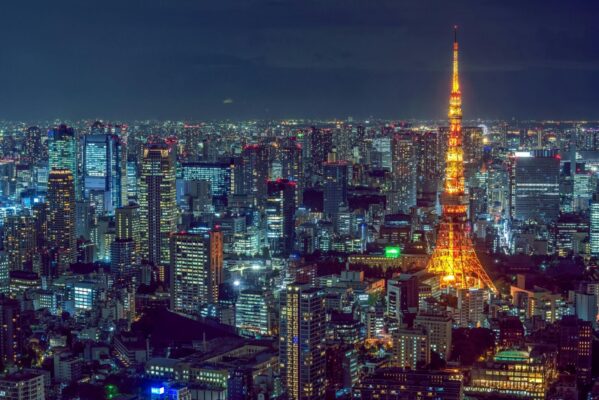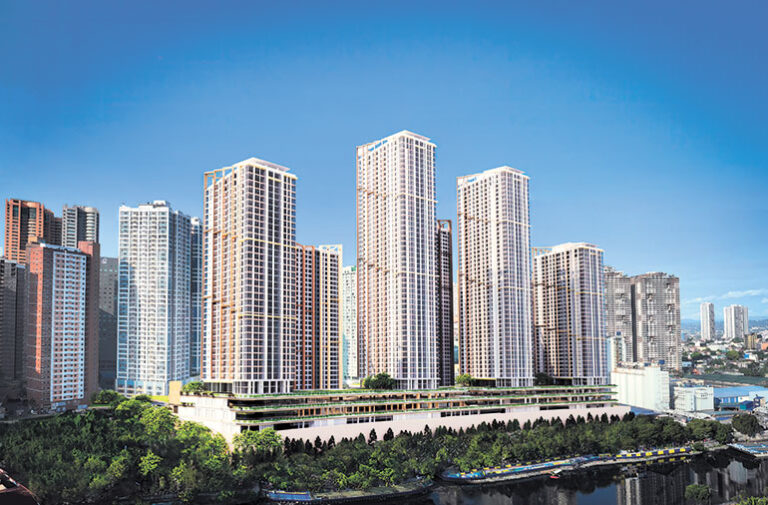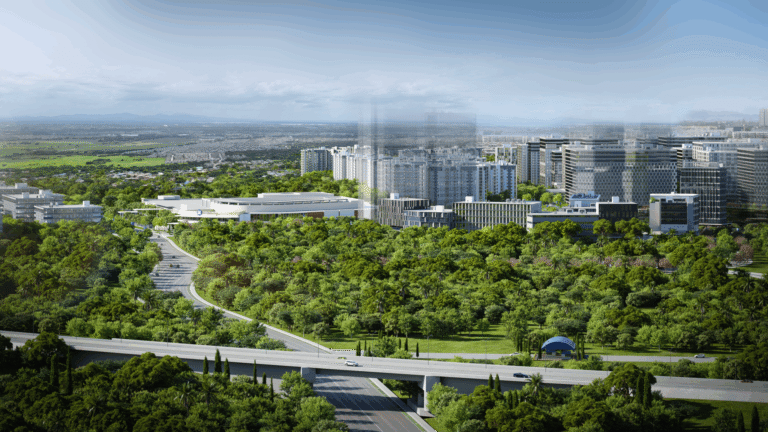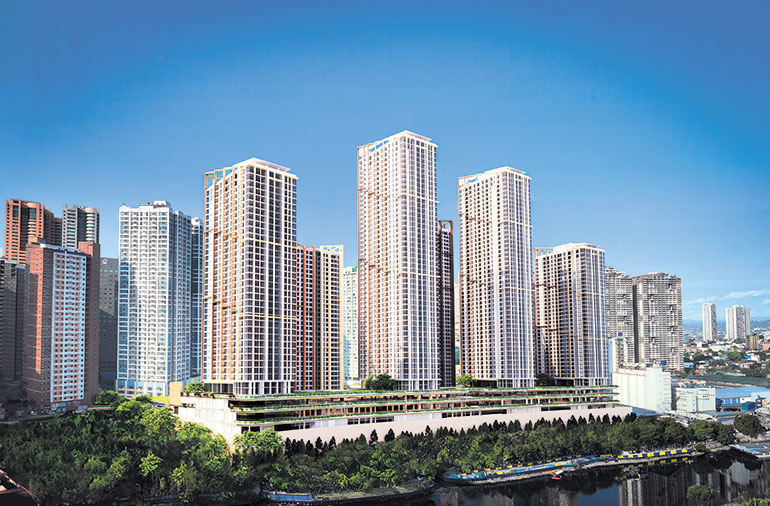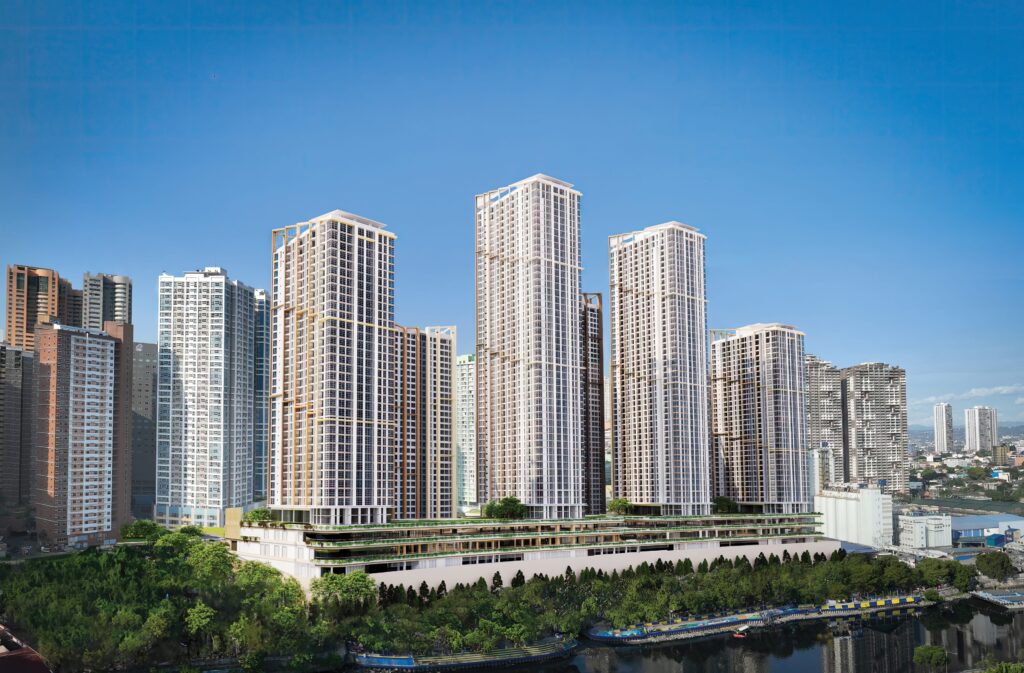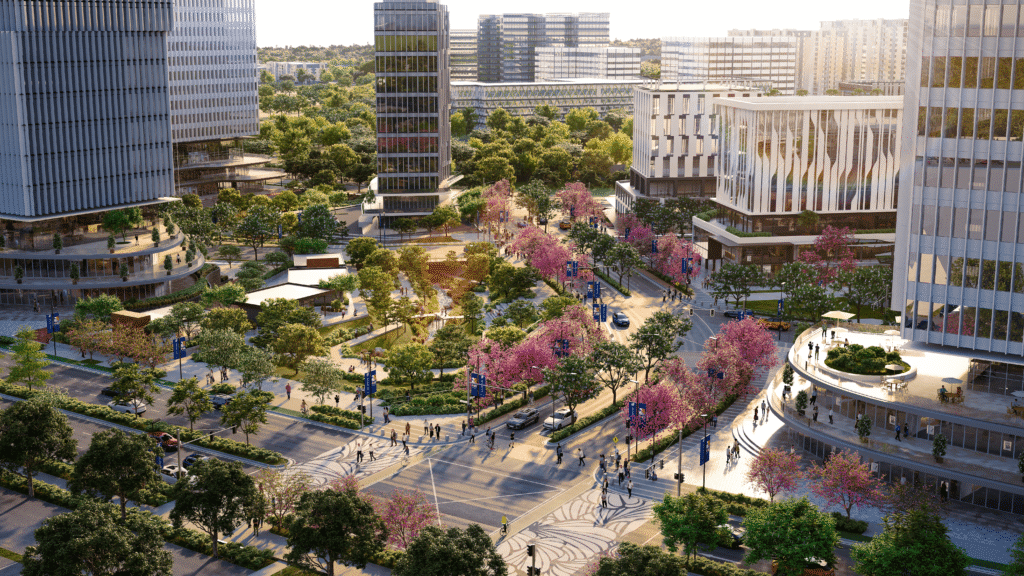From strategic space planning to efficient use of energy and the Japanese philosophy of kaizen, there is so much to learn from the Land of the Rising Sun
There are so many things to love about Japan—nice seasonal weather, cherry blossoms, fresh seafood, a rich cultural tapestry, and the list goes on. Beyond its natural and cultural allure, Japan is admired for its efficient transportation and impeccably clean public spaces. Besides the country’s meteoric progress, the Japanese people are also known for being organised and for their life-changing philosophies like ikigai (a reason to live), wabi-sabi (embracing life’s imperfections), and kaizen (continuous improvements), among many others.
On a week-long trip to Tokyo, Federal Land NRE Global (FNG) Inc took Tatler around some of Nomura Real Estate (NRE) Development’s projects to better understand what Japanese ingenuity and intentionality are all about. It could be recalled that in 2022, the two real-estate giants, Federal Land, Inc and NRE, sealed an alliance to form FNG, a joint venture that aims to combine Japanese innovation and Filipino sensibilities through its developments in the Philippines. “This is a perfect marriage of vision and values. We share a common long-term outlook, anchored on creating world-class developments that enrich people’s lives, says Federal Land Chairman and Tatler Asia’s Most Influential honouree, Alfred Ty. “FNG is a sustainable enterprise focused on long-term real estate development in the Philippines. Currently, FNG oversees four development sites in Metro Manila and Cebu, with a combined project cost of approximately US$5 billion,” says Masato Yamauchi, Nomura Real Estate Development Co Ltd Head of Overseas Business, as he welcomed our group at the NRE office in Shinjuku.


Prior to forming FNG, NRE’s operations in the Philippines started in 2017 with its mixed-use residential and commercial development in Bonifacio Global City, which it has been promoting in collaboration with Federal Land, Inc and Isetan Mitsukoshi, one of Japan’s largest department stores. The residential tower, named The Seasons Residences, was anchored on the “Japan Concept” and features units named after the four seasons of Japan.


According to Yamauchi-san, NRE was founded in 1957, when all Japanese people were rebuilding their lives post-Second World War. “It was a period of rapid economic growth, accompanied by significant housing shortages, which became a critical social issue. NRE responded by undertaking the ambitious mission of developing large-scale new towns to provide housing for all citizens,” Yamauchi-san explains. Today, NRE continues to expand its scope to include condominiums, office buildings, retail properties, and more to respond to evolving social needs.
Here are some of the key takeaways from five days of exploring NRE projects in Tokyo:
1. Minimalist and Functional Living
Arriving in rainy Tokyo, the Philippine media delegation was chauffeured to Nohga Hotel Akihabara Tokyo in Soto-Kanda, a district popular for electronics, shopping and anime. While the cosy 18sqm double room might appear small at first glance, diving deep into its details would make one realise that despite the limited space, the room is complete with everything one needs to enjoy a stay in Japan.

Upon entering the room, one is greeted by a short hallway with ample storage for luggage and a wardrobe. A wooden sliding door (a typical space-saver in most homes in Japan) opens to the bedroom area, where a plush queen-sized bed bathed in warm lighting instantly lures guests to relax and sleep the night away. The room is also decked with high-quality speakers and an up-to-date entertainment system, allowing guests to enjoy local music and films. Those who need to catch up on work or want to indulge in snacks or coffee may do so in a well-lit nook in one corner of the room. In addition, the compact bathroom is equipped with heated toilet seats, bidet functions and a rainshower with adjustable water temperature and pressure—a feature Japanese bathrooms are known for.
All of these functionalities can be experienced within an 18sqm room—a perfect example of how the Japanese maximise every inch of living space without sacrificing comfort, aesthetics or the environment.
2. The Japanese Philosophy of Kaizen
The second day of the tour highlighted the Shibaura Project, a complex redevelopment just a few minutes away from Hamamatsucho Station. The location is ideal for global businesses as there is direct 13-minute monorail access to Haneda Airport.
Subscribing to kaizen, or the Japanese philosophy of embracing changes for continuous improvement and efficiency, is central to any NRE development, and the Shibaura Project is no exception. Designed with the needs of the locals in mind, the complex highlights amenities and features that make it an ideal place for work and play. To illustrate, while the Shibaura Project’s location is conveniently accessible via public transportation, the developers also see the need to create covered walkways from the stations and bus stops all the way to the office buildings so that employees can walk comfortably even in rainy season or during sunny days. This biophilic umbrella-free route from the station catches sunlight filtering through the trees, allowing one to emerge in nature—a luxury for those living in fast-paced cities like Tokyo.

Facing the scenic Tokyo Bay, the two towers of the Shibaura Project—Tower S and Tower N—will have offices and retail spaces. Tower S will have the first-ever Fairmont Hotel in Japan on the upper levels, while residences will occupy the upper levels of Tower N.
For the benefit of the tenants who will occupy the two towers, amenities to give them a cosy and efficient workcation environment are in the works, such as a Sky Lounge, conference and banquet areas, wellness and vacation areas, and a co-creation/networking area. There will also be a satellite-style co-working space for those who need to work remotely, as well as workstations and lounges set amidst relaxing greenery.
At the food halls, nutritious and reasonably priced meals will be offered. Tenants can also walk a few metres across to enjoy international cuisine at Hi-Node, a casual all-day dining seaside restaurant fronting Tokyo Bay.
“In order to localise, it is especially important to deeply explore local needs. FNG takes Japanese design philosophies and localises them for the Filipino market. Not everything that is done in Japan will work in the Philippines. In FNG, careful and thoughtful consideration of what is essential to the customer’s needs is practised throughout the project development process. Specifically, we recognise that the results of kaizen and other activities are beginning to appear in The Seasons Residences,” says Atsushi Ogata, Nomura Real Estate Development Co Ltd Executive Officer, when asked how the company plans to align the distinctive qualities of Japanese design with the needs of the Philippine market.
“We strongly believe that the real estate business is inherently local. Therefore, it’s crucial to adapt flexibly to meet the specific needs and practices of local customers rather than merely applying Japanese know-how and experience. At FNG, we have a dedicated team of 13 Japanese employees. With their profound understanding of the Philippines, they actively participate in business promotion from the early stages, such as product planning and design. They are committed to applying Nomura Real Estate’s expertise to local manufacturing processes here in the Philippines,” adds Yamauchi-san.
Through kaizen, NRE created a place sensibly designed to promote work-life balance.
3. Efficient Use of Energy
The towers at the Shibaura Project use a hybrid radiant-convective air-conditioning system. To put it simply, radiant air-conditioning systems operate by passing water through radiant panels installed in the ceiling, providing temperature control while maintaining low airflow. There are image sensors that can gauge the occupancy of a room, which are used to control lighting and temperature, which means that when fewer people are detected, less energy will be generated while still ensuring a comfortable working environment. The double-glazed glass windows achieve approximately four times the thermal insulation, while automatic sun-tracking electric blinds shield the space from direct sunlight. In the event of air-conditioning interruptions, natural ventilation is guaranteed through hopper vents.

In addition, Nomura Real Estate Group, Inc has its own solar power generation and adopts a high-efficiency district heating and cooling system. “In Japan, we have achieved exceptional energy-saving products through enhanced thermal insulation and the adoption of clean energy. Therefore, we anticipate that these products would be highly feasible and beneficial in the Philippines,” Yamauchi-san says.
Continuing the tour of NRE projects, the group explored NRE’s headquarters in Shinjuku, which houses the Proud Gallery, an interactive concept room and a model unit that gives a capsule view of the Proud residential brand, which ranked as the number one condominium in Japan for 16 consecutive years. Here, the team learnt that the Japanese developer utilises the enecoQ energy management system, which uses a service for purchasing high-voltage electric power for entire buildings as well as information and communications technologies (ICT) to curtail peak electric power consumption, and it uses the demand forecasting models developed for the enecoQ service to procure electric power efficiently.
4. Sustainability is Key
Besides convenience, functionality and aesthetics, there are conscious sustainability efforts in most homes and establishments in Japan. In the NRE-owned Nohga Hotel Akihabara Tokyo, for example, guests can borrow an umbrella or a bicycle that they can use to explore the neighbourhood. This encourages guests to walk or move around while minimising fuel use and, ultimately, their carbon footprint.

“Sustainability is very important [to us]. We manage 130 hectares of forests owned by Tokyo-Okuchi, engaging in activities such as afforestation, conservation, and the efficient utilisation of timber for our project. These efforts have significantly contributed to decarbonisation,” says Yamauchi-san. “This is a very rare project for other companies in Japan, and it should indicate the high level of our interest in sustainability. Needless to say, sustainability is always important in the Philippines business, and development is carried out.”
Putting this into perspective, NRE is gearing towards achieving net zero CO2 emissions across the entire block of the Shibaura Project by introducing solar power generation and using carbon-neutral city gas. Carbon-neutral city gas uses liquefied natural gas that does not emit carbon dioxide.
5. Calamity Preparedness and Disease Control
Like the Philippines, Japan has also experienced strong earthquakes and typhoons, and with this, it is essential to incorporate countermeasures into the designs of offices, residences and commercial buildings.
The entire building of the towers of the Shibaura Project comprises a hybrid structure with vibration control and seismic base isolation devices. In the event of a power interruption during a disaster, emergency power generators and a cogeneration system can supply power for up to approximately ten days.
“Japan has developed advanced technologies to respond to earthquakes and other disasters, showcasing global leadership in safety and security. We take pride in Japan’s commitment to these efforts, which are among the most rigorous worldwide”
– Masato Yamauchi –
The design of the building also took into consideration the Minato City Tsunami Hazard Map and the existing sea walls since the property is near the Tokyo Bay area. All the major electrical equipment is also installed above ground level on the second floor and higher (as opposed to the traditional basement installation) to ensure continuity of building operations in the event of flooding.
Due to the pandemic, infectious disease control measures, such as continuous and enhanced ventilation, contactless flap gates and thermal scanners at the entrances, and elevators compatible with high-performance filters, are also in place.
“Japan has developed advanced technologies to respond to earthquakes and other disasters, showcasing global leadership in safety and security. We take pride in Japan’s commitment to these efforts, which are among the most rigorous worldwide,” says Yamauchi-san.
6. Smart Space Planning
At the Proud Gallery in Shinjuku, the group got a sneak peek at a Proud condominium unit. The automated door opens to a genkan (a traditional Japanese entryway where owners and guests take off their shoes before entering the unit). On the left is a built-in shoe closet, and on the right is a small foyer. The master bedroom immediately follows—its space has more than enough room to move around, considering there’s a plush queen-sized bed and an elegant glass wardrobe.


The inviting living room is next to the dining space, which faces the kitchen, complete with a built-in wine chiller, stove, griller, oven, and dishwasher. The prep island counter also has a sink with a composter to properly manage biodegradable waste. Adjacent to the dining area and kitchen is a spacious veranda that commands beautiful Tokyo skyline views.
An interesting point in the design of Proud condominiums is that they leave ample space beneath the flooring where the pipes are located. This gives the owners the flexibility to reconfigure the rooms in the house, including areas with plumbing, such as the kitchen and the bathroom, conveniently because the pipes can be moved around easily without the need to redo the entire structure.



On the third day of the tour, the NRE team brought the group to Proud Season Inagi Minamiyama. A typical three-bedroom detached house layout here starts with a pocket garden that blends in perfect harmony with the natural surroundings. The kitchen and dining area are on the first floor, which flow seamlessly to the bright, airy double-height living area. On the other side of the kitchen is a door that leads to a walk-in closet and the bathroom, complete with a full-sized tub. The second floor has the bedrooms, one of which has another walk-in closet and a veranda.
“In the Philippines, storage is often seen merely as a place for keeping items, whereas in Japan, it’s designed as a thoughtfully planned facility to optimise space usage. We are striving to enhance existing infrastructure in the Philippines with the meticulous attention to detail characteristic of Japan’”
– Atsushi Ogata –
As explained by the NRE team, the houses here have flexible storage systems designed with the users’ “flow” in mind. For instance, when the homeowners go grocery shopping, they can easily store the items they bought at the pantry, which is just near the entrance. This pantry is also connected to the kitchen. On the other hand, the laundry area is adjacent to the open-air balcony, where one can dry their clothes. The balcony is connected to the bedroom, where the wardrobe storage is. Underneath the stairs is a cupboard that looks much more inviting and organised than that of the Dursleys, where Harry Potter used to stay.
“In the Philippines, storage is often seen merely as a place for keeping items, whereas in Japan, it’s designed as a thoughtfully planned facility to optimise space usage. We are striving to enhance existing infrastructure in the Philippines with the meticulous attention to detail characteristic of Japan, a move that has been well-received by our customers. We categorise these efforts under the banner of ‘Japanese Ingenuity’,” says Ogata-san.


Exterior space planning is also important for NRE, as homeowners are allowed to expand their living spaces to the outdoors through pocket gardens and al fresco lounge areas.





On a bigger scale, NRE also implements smart space planning in commercial establishments. An example of this is how the Kameido Clock (a community mall across the Proud Tower Kameido Cross condominium) achieves the “shower effect” throughout the building. The shower effect is attained by strategically placing the establishments with high foot traffic at the top and basement floors of the building so that customers, naturally, will be able (and sometimes enticed!) to explore the other floors with more merchants. In Kameido Clock’s case, dining spots and a food market are located on the fourth and basement floors, respectively. Between these floors are a Yokocho-style dining hub, lifestyle and speciality stores, home items, a bookstore, gaming and recording studios, and wellness centres.


The meticulous attention to detail in Japanese design offers valuable lessons for creating sustainable and innovative spaces. FNG’s endeavours in the Philippines—in Metro Manila (The Observatory), Cavite (Yume) and soon in Cebu—hold promise for translating these principles into transformative developments.
Motivated by these philosophies, discover sustainable Japanese-inspired environments through a real estate company in the Philippines that embeds wellness, eco-friendly systems, and timeless design into every project.
Experience this approach at The Observatory, where energy-efficient systems, green terraces, and flexible floor plans come together in a Mandaluyong high-rise that champions mindful urban living.
